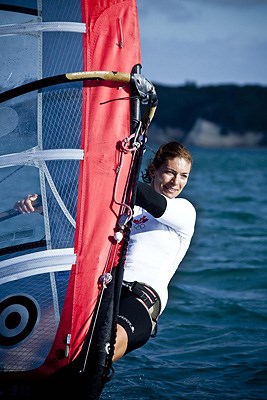Vancouver athlete Nikola Girke competed in two Summer Games in two different sports, sailing and windsurfing. The West End resident returns to the Olympics for the third time this summer in London, determined to step on the podium before windsurfing is replaced as an Olympic event.
Girke secured a berth at the London Games as Canada's sole female competitor in windsurfing after placing 10th at the RS: X World Windsurfing Championships in Cadiz, Spain this March.
She first learned the ropes as a sailor at Eagle Harbour Yacht Club in West Vancouver and eventually began competing as a teenager at the Royal Vancouver Yacht Club, where she became fast friends with Jennifer Provan.
The two teamed up to compete in the 470 sailboat category at the 2004 Athens Games, finishing 13th overall. Girke then made the switch to windsurfing and joined an exclusive club of athletes who have competed at the Olympics in multiple sports. In windsurfing, Girke placed 17th out of 27 at the 2008 Beijing Games.
"I am super proud and excited to represent Canada at the London Olympic Games," she said shortly after posting her best world championship finish in Spain. "Because there is only one person per nation at the Games, it's already a lot closer and a big step towards standing on the podium."
She also hopes sailing conditions will be a lot better than they were at the last Olympics. Just as the lack of snow was a major issue at Cypress Mountain during the Vancouver Winter Games, a distinct absence of wind plagued competitors in all 10 sailing classes at the Beijing Games, making the races less entertaining and much more difficult.
"When people think of windsurfing, they often think of riding waves and going fast when it is always windy. Unfortunately it's not always like that and we do it in every single condition, from three to 30 knots on the same equipment," she said.
With close ties to both sailing and surfing cultures in Southern California, windsurfing rose to popularity as a recreational pursuit in the 1980s and debuted as an Olympic sport at the 1984 L.A. Games
Girke said the calm conditions in Beijing made for unusually dull but physically exhausting racing in what's otherwise an exciting spectator sport. Competitors had to repeatedly upright their large, heavy sails to generate their own forward motion when they couldn't rely on the wind in order to hydroplane, also known as planing.
"In Beijing there was basically no wind, and when there is no wind we really have to pump, which is extremely physical and hard work," she said. "You're fanning the sail over and over and over and over again, which creates momentum and movement and you can create forwards drive from that. Ideally there is enough wind where we can get to the point where we are planing and that is a whole different ball game. That is the real windsurfing."
Whichever way the wind blows in London, the 34year-old said she doesn't intend on hanging up her sails anytime soon.
"It is one of the most physically intensive Olympic sports but also really experienced based," she said, noting the importance of situational and tactical experience. "The older sailors have the experience from all their years and as long as they can stay fit and recover well from being injured, they can be just as competitive if not more so."
KITEBOARDING TAKES OFF IN RIO
Although windsurfers stay competitive well into their 40s, athletes like Vancouver's Nikola Girke won't be vying for Olympic gold after London 2012. On May 5, the International Sailing Federation decided windsurfing will be replaced by kiteboarding at the 2016 Rio Summer Games. In kiteboarding, a competitor standing on a board controls a kite to move over the surface of the water. In windsurfing, a competitor controls a sail attached to the board.
-Megan Stewart
Twitter: @flematic



